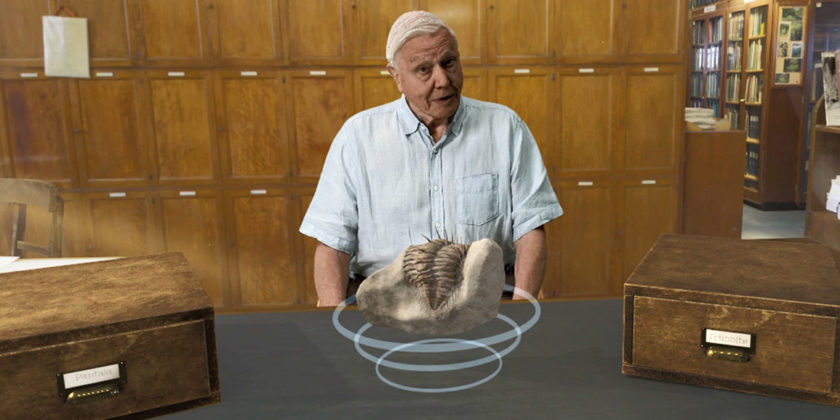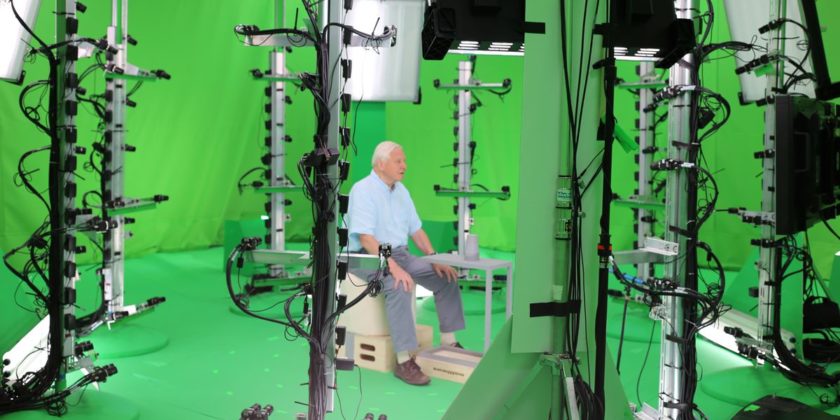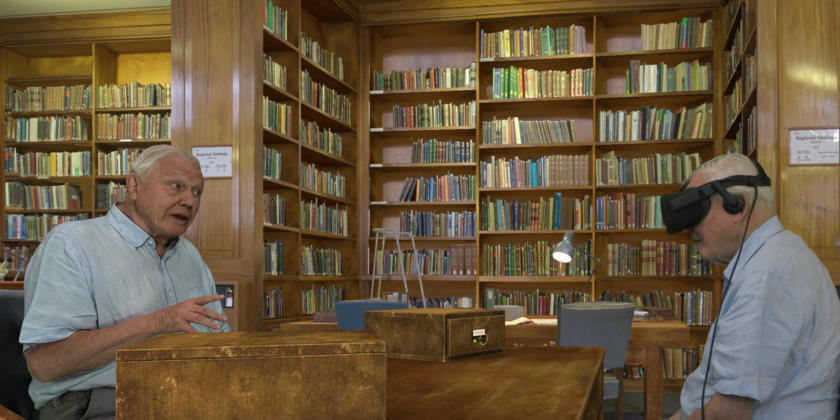“Hold the World is an extraordinary next step in how we can communicate and educate people about experiences they wouldn’t usually have access to in the real world. I am delighted about what users can learn and discover from the Natural History Museum’s treasures in this new VR experience – it really is one of the most convincing and bewitching experiences that the world of technology has yet produced.”
– Sir David Attenborough
Going behind the scenes at the Natural History Museum to explore its hidden treasures would usually be a unique treat for the lucky few; but coupling this with a personal tour from Sir David Attenborough is the stuff of dreams for those with a sense of wonder and curiosity of the world around them.
But this has now become a reality, thanks to the development of Hold the World, a groundbreaking VR experience conceived and produced by immersive content studio, Factory 42, in association with Dream Reality Interactive, Alter Equals, The Mill and Talesmith, and commissioned by Sky VR Studios.
By combining cutting-edge technologies in a way never seen before, Hold the World takes participants on an extraordinary immersive journey through the back rooms of the museum, lasting up to an hour. Through the digital re-creation of actual spaces, coupled with the scientifically accurate depiction of specimens and a life-like holographic image of Sir David Attenborough, Hold the World has a sense of realism that takes immersive experiences to a whole new level.
About the experience
“Hold the World gives the Natural History Museum a chance to open up its collection and have access to its hidden treasures. Participants are able to get up close and handle rare and hidden objects in a way that would be unthinkable in real life, as well as getting to visit areas of the museum ordinarily accessible only to museum staff,” explains John Cassy, Co-Founder of Factory 42.
Participants begin the experience in a corridor in the Natural History Museum, and have the choice of three doors to go through. These lead the participant to either the Conservation Centre, the Earth Sciences Library or the Cryptogamic Herbarium. Once in there, participants are introduced to Sir David Attenborough who sits opposite them throughout, inviting them to open a series of boxes and picking up the specimen inside. These include a blue whale, stegosaurus, trilobite, dragonfly, butterfly and ptersosaur; all based on rare specimens kept within the museum’s collections.
Sir David then tells the story of the specimen, explaining more about its history and the science behind it, during which time the participant can look at it in detail, changing the size and zooming in on specific areas. Once fully examined, the specimen magically comes to life before the participant’s eyes.
How it was created
Over a year in development, Hold the World is a hugely ambitious project that mixes gaming with documentary filmmaking. Developed from an initial concept from Factory 42’s founders, Dan Smith and John Cassy, the project was a truly collaborative experience, where leading creatives from different industry sectors worked alongside each other and museum representatives to make the experience as authentic as possible.
To develop Hold the World, a combination of cutting edge technologies were applied in ways that had never been undertaken before. Photogrammetry was used to accurately re-create the rooms in the Natural History Museum and was led by Alter Equals founders Nicolas Galan and Fabien Micallef .
The cutting-edge holographic image of Sir David was created by volumetric capture over 5,000 miles from the museum at Microsoft’s headquarters in Seattle, where over 100 cameras were used to accurately capture his every move. Objects were scanned using a range of techniques by the Natural History Museum’s in house scanning department and a group of their scientists. The award winning VFX company, the Mill animated each of the objects, bringing each to life in a realistic and magical way. Factory 42 worked closely with the National History Museum’s curators and scientists to ensure each specimen recreation was scientifically accurate.
The experience was then brought together in a game engine by DRi, which also created the interactions, under the direction of Dan Smith and close collaboration from DRi game designer John Foster and DRi art director Laura Dodds. Sky’s in house VR team, led by Neil Graham, contributed to and reviewed the production throughout the process in order to create the highest quality and most robust consumer experience.
Making it real
“We needed people to really believe they were sitting opposite Sir David Attenborough”
– John Cassy
The success of the experience relied entirely on every detail being accurately recreated, from the image of Sir David, through to the tiniest detail on each specimen. Without this, the project would lose its sense of reality and believability for participants, as well as compromising the reputation of the Natural History Museum. “We worked closely with the teams at the museum, gaining their trust and drawing on their expertise” explains John. “They were central to the whole production, working closely with the Mill throughout the process of creating, animating and ultimately approving the way each specimen was portrayed”.
Maintaining a strong narrative and working effectively together
Hold the World is driven by a strong narrative. Given the complexity of the project, including the number of people and organisations involved in its development, coupled with the limited access to Sir David’s time, meant that in order to keep production on track, scripts needed to be tight, and strictly adhered to.
One of the challenges of the project was collaborating effectively. While working with the best companies in their fields, bringing together firms from different sectors meant everyone had to be mindful of other people’s workflows and ways of working. Maintaining communications was central to tackling this issue, to ensure all the parts of the production worked seamlessly with each other. “No-one had done something like this before so we were incredibly fortunate to have the unwavering support of Sky and a great team of creative and technical experts to work with,” said John.
Challenges in distribution
The experience launched to the media in March 2018, and is available on site in the museum, as well as more widely available on the Sky VR App.
“Given the technical complexity and realism of the experience, it’s a data hungry project, as the size of the files are huge. This is something that we had to address creatively, as it potentially risked crashing the headsets while participants were in the experience” John notes.
The future: unparalled access to museum collections
“Virtual reality is a really important new tool for getting our specimens out there and letting the public see them really up close and manipulate them. It’s the first time people will actually be able to hold these objects, pull them around and make them larger and smaller. It’s been a really exciting development for us here, because we are also seeing it in new ways for the first time too.”
– Professor Paul Barrett, Natural History Museum, who also worked on the Stegosaurus model and animation.
John believes that immersive technologies could revolutionise the museum sector as well as providing an exciting educational tool to engage with visitors. “With museums’ collections significantly outstripping space to exhibit, visitors will only ever be able to view a fraction of the specimens they hold. By scanning and faithfully replicating specimens in a virtual space, visitors won’t just get to see these hidden, rare treasures, but will be able to get close to, and examine specimens in a way that would be impossible in the real world.”
Moreover, VR could also provide solutions to widening access to those that may find it impossible to travel to museums. “With around five million visitors a year, the Natural History Museum is one of the most popular attractions in the UK. But for many, visiting will never be an option, as they will always be challenged by its geographical location. Immersive technologies have the potential to change this significantly, by getting collections out of the museum and into headsets that can be used anywhere” comments John.
“Museums can take specimens that people on the other side of the world are working on. It’s a democratisation or universalisation.”
– Sir David Attenborough


